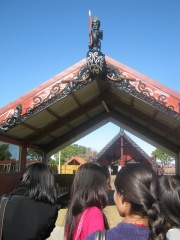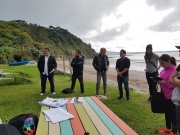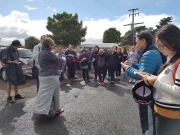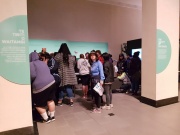Field Trip
From WikiEducator
←Teaching Te Tiriti o Waitangi
AIMS:
To assist the students to see the relevance of the treaty today, to investigate local landmarks where historical events leading up to and following the signing of the treaty took place, to appreciate the resources we have here in Auckland, how our ancestors viewed these resources, and how the treaty has helped to protect these resources.
OUTCOMES:
- Identify local landmarks of relevance to the treaty – historically and today
- Identify the resources available to us in Auckland – how Auckland developed and how these resources can be protected
- Increased awareness of our environment and our responsibilities to the environment through honouring the treaty
MATERIALS/RESOURCES:
- Planned trip: buses, itinerary, tasks to be completed
- Auckland itself (similar trips to these would be valuable all over New Zealand as no area of New Zealand was untouched by Te Tiriti o Waitangi)
- Tangata whenua and dignitaries at various Auckland destinations
INSTRUCTIONAL PROCEDURES:
This would vary according to the trip details. All trips start and end with karakia. Some previous trips include:
- Trip 1: Visit 5-6 major landmarks around Auckland of relevance to the treaty – a worksheet to accompany this tour: destinations include: Karaka Bay (a signing occurred here); Manukau Harbour; Britomart (where Hobson signed a document with Ngati Whatua allowing the CBD to be developed); early government houses at Auckland University; Hobson’s grave, etc.
- Trip 2: Okahu Bay – visiting places of relevance to the treaty – classes preparing a skill to teach the rest of the Level 4 students at Okahu Bay, e.g. poi making, kite flying, and/or incorporating a ‘Mathex’-style challenge on topics relating to Te Tiriti
- Trip 3: Bastion Point – visit the marae at Bastion Point under the guidance of the tangata whenua of the area – the students are usually split into groups and have a discussion in the marae, view the film made by the Ngati Whatua on the events at Bastion Point and are taken on a guided tour
- Trip 4: Stonefields – students are split into seven groups, seven lecturers are stationed around the Stonefields, and each lecturer discusses his/her area and its significance – students complete a worksheet (Note: this is a particularly relevant and vital destination currently - local tagata whenua are fighting to protect this area from a proposed housing development project - check out their campaign on Facebook)
- Trip 5: Museum – a Great Race competition completed around sections of the museum: early Auckland, volcanoes, the Māori Court, Polynesian displays, etc. or a worksheet to complete while walking the Treaty Trail and examining the Treaty of Waitangi Exhibition (here is an example of a worksheet, together with the answer sheet)
EVALUATION:
- Completed worksheets on the relevant trip
- A group task completed
- Ability to actively participate in discussion
- Reflection 3 completed for assessment – the topic would deal with the development of Auckland and its resources







